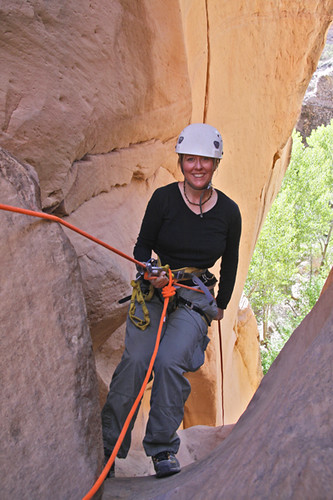 As water and ice eroded the sandstone cliffs of the Colorado Plateau, hoodoos were formed. Named by the Spaniards and derived from the same source as the word voodoo, these free-standing rock formations were considered sacred by Native Americans. You'll find these unique natural structures all around Bryce Canyon in southern Utah.
As water and ice eroded the sandstone cliffs of the Colorado Plateau, hoodoos were formed. Named by the Spaniards and derived from the same source as the word voodoo, these free-standing rock formations were considered sacred by Native Americans. You'll find these unique natural structures all around Bryce Canyon in southern Utah.  They come in many shapes and sizes. One night, we camped at Kodachrome Basin State Park, where "Big Stony" — a phallus-shaped "sand pipe" — overlooks the campground. Others look like humans; take the Queen's Garden Trail from Sunrise Point in Bryce Canyon down through what is known as the amphitheater (although I think of it more like a giant sculpture garden) and you'll come across a portly Queen Victoria overlooking the landscape.
They come in many shapes and sizes. One night, we camped at Kodachrome Basin State Park, where "Big Stony" — a phallus-shaped "sand pipe" — overlooks the campground. Others look like humans; take the Queen's Garden Trail from Sunrise Point in Bryce Canyon down through what is known as the amphitheater (although I think of it more like a giant sculpture garden) and you'll come across a portly Queen Victoria overlooking the landscape. During our first attempt to take the aforementioned trail, a lightning storm rolled in and we stayed safely in our car, due to a lightning risk. Afternoon storms are common in the summer months, and the risk of being struck by lightning is highest at Bryce--three people have lost their lives and 18 have been injured in the last 15 or so years.
During our first attempt to take the aforementioned trail, a lightning storm rolled in and we stayed safely in our car, due to a lightning risk. Afternoon storms are common in the summer months, and the risk of being struck by lightning is highest at Bryce--three people have lost their lives and 18 have been injured in the last 15 or so years.The weather was much better the next day, when we hiked from Sunrise Point down to the bottom of the canyon. At each turn the sculptured sandstone cliffs and hoodoos elicited excitement from the many tourists along the path. At the bottom, the trail ended and another took its place. The Navajo loop trail went through a pine forest and then ended with an 800-foot climb out of the amphitheater along a switchback trail that left me out of breath, but the breathtaking views were worth it.





